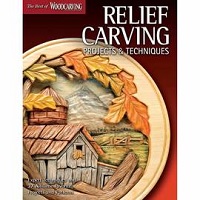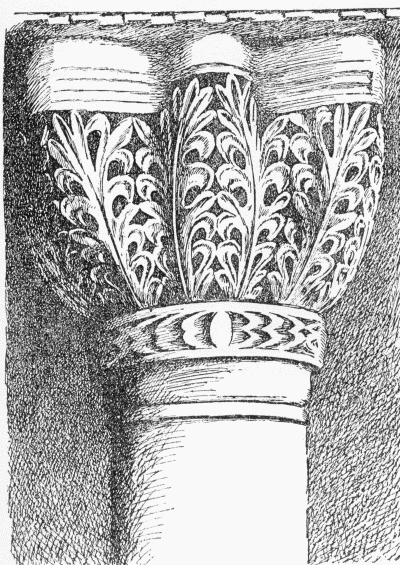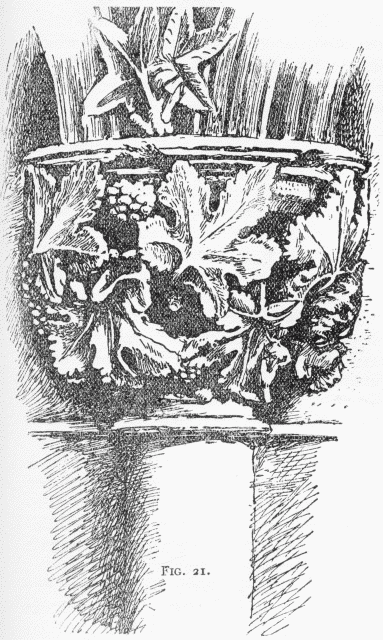CHAPTER X
THE PATTERNED BACKGROUND
Importance of Formal Pattern as an Aid to Visibility - Pattern and Free Rendering Compared - First Impressions Lasting - Medieval Choice of Natural Forms Governed by a Question of Pattern.

CLICK HERE CLICK HERE By a comparison of the piece of Byzantine sculpture, Fig. 20, with the more elaborate treatment of foliage shown in Fig. 21, from late Gothic capitals, in Southwell Minster, it will be seen how an increasing desire for imitative resemblance has taken the place of a patterned foundation, and how, in consequence, the background is no longer discernible as a contrasting form. The Byzantine design is, of course, little more than a pattern with sunk holes for a background, and it is in marble; but those holes are arranged in a distinct and orderly fashion.
The other is a highly realistic treatment of foliage, the likeness to nature being so fully developed that some of these groups have veins on the backs of the leaves. The question for the moment is this, which of the two extremes gives the [98] clearest account of itself at a distance? I think there can be little doubt that the more formal arrangement bears this test better than the other, and this, too, in face of the fact that it has cost much less labor to produce.
Remember, we are only now considering the question of visibility in the design. You may like the undefined and suggestive masses into which the leaves and shadows of the Southwell one group themselves better than the unbending severity of the lines in the other, but that is not the point at present. You can not see the actual work which produces that mystery, and I may point out to you, that what is here romantic and pleasing on account of its changeful and informal shadows, is on the verge of becoming mere bewildering confusion; a tendency which always accompanies attempts to imitate the accidental or informal grouping of leaves, so common to their natural state.
The further this is carried, the less is it possible to govern the forms of the background pattern; they become less discernible as contrasting forms, although they may be very interesting as elements of mystery and suggestive of things not actually seen. The consequence is a [100] loss of power in producing that instantaneous impression of harmony which is one of the secrets of effectiveness in carving. This is greatly owing to the constant change of plane demanded by an imitative treatment, as well as the want of formality in its background. The lack of restful monotony in this respect creates confusion in the lights, making a closer inspection necessary in order to discern the beauty of the work. Now the human imagination loves surprises, and never wholly forgives the artist who, failing to administer a pleasant shock, invites it to come forward and examine the details of his work in order to see how well they are executed.
These examples, you will say, are from architectural details which have nothing to do with wood-carving. On the contrary, the same laws govern all manner of sculpturesque composition - scale or material making no difference whatever. A sculptured marble frieze or a carved ivory snuff-box may be equally censurable as being either so bare that they verge on baldness and want of interest, or so elaborate that they look like layers of fungus.
Do not imagine that I am urging any preference for a Byzantine treatment in [101] your work; to do so would be as foolish as to ask you to don medieval costume while at work, or assume the speech and manners of the tenth century. It would be just as ridiculous on your part to affect a bias which was not natural to you. I am, however, strongly convinced that in the choice of natural forms and their arrangement into orderly masses (more particularly with regard to their appearance in silhouette against the ground), and also in the matter of an economical use of detail, we have much to learn from the carvers who preceded the fourteenth century. They thoroughly understood and appreciated the value of the light which fell upon their work, and in designing it arranged every detail with the object of reflecting as much of it as possible. To this end, their work was always calculated for its best effects to be seen at a fairly distant point of view; and to make sure that it would be both visible and coherent, seen from that point, they insisted upon some easily understood pattern which gave the key to the whole at a glance. To make a pattern of this kind is not such an easy matter as it looks. The forms of the background spaces are the complementary parts of the [102] design, and are just as important as those of the solid portions; it takes them both to make a good design.
Now I believe you must have had enough of this subject for the present, more especially as you have not yet begun to feel the extraordinary difficulty of making up your mind as to what is and what is not fit for the carver's uses among the boundless examples of beauty spread out for our choice by Dame Nature.
Meantime, I do not want you to run away with the impression that when you have mastered the principles of economy in detail and an orderly disposition of background, that you have therefore learned all that is necessary in order to go on turning out design after design with the ease of a cook making pancakes according to a recipe. You will find by experience, I think, that all such principles are good for is to enforce clearness of utterance, so to speak, and to remind you that it is light you are dealing with, and upon which you must depend for all effects; also that the power of vision is limited. Acting upon them is quite another matter, and one, I am afraid, in [103] which no one can help you much. You may be counseled as to the best and most practical mode of expressing your ideas, but those thoughts and inventions must come from yourself if they are to be worth having.
In my next lecture I shall have something to say with regard to originality of design, but now we must take up our tools again and begin work upon another exercise.
WOODCARVING BOOK - TABLE OF CONTENTS | WOODCARVING BOOK - INDEX OF TOPICS

|
INFORMATION ABOUT HOW TO MAKE MONEY FROM WOOD CARVING |



